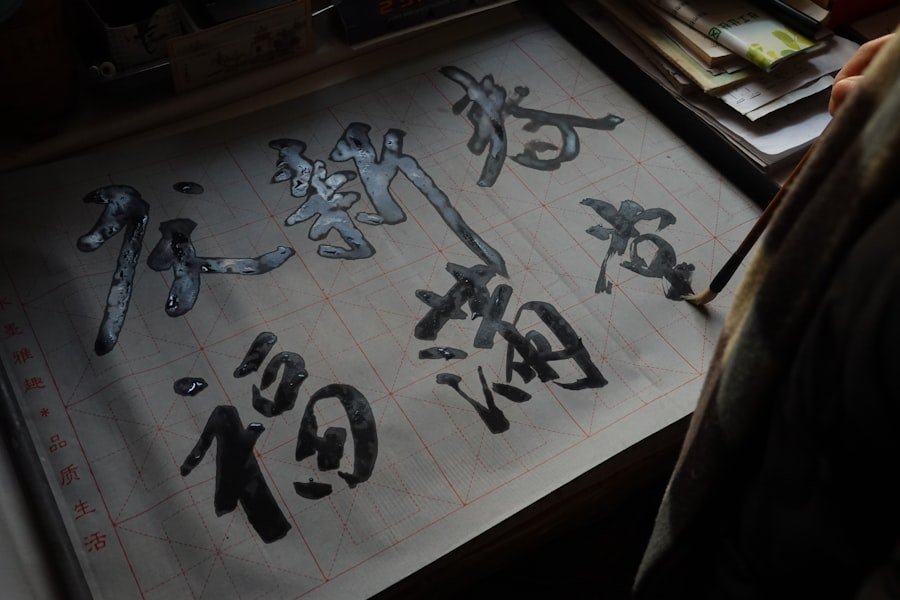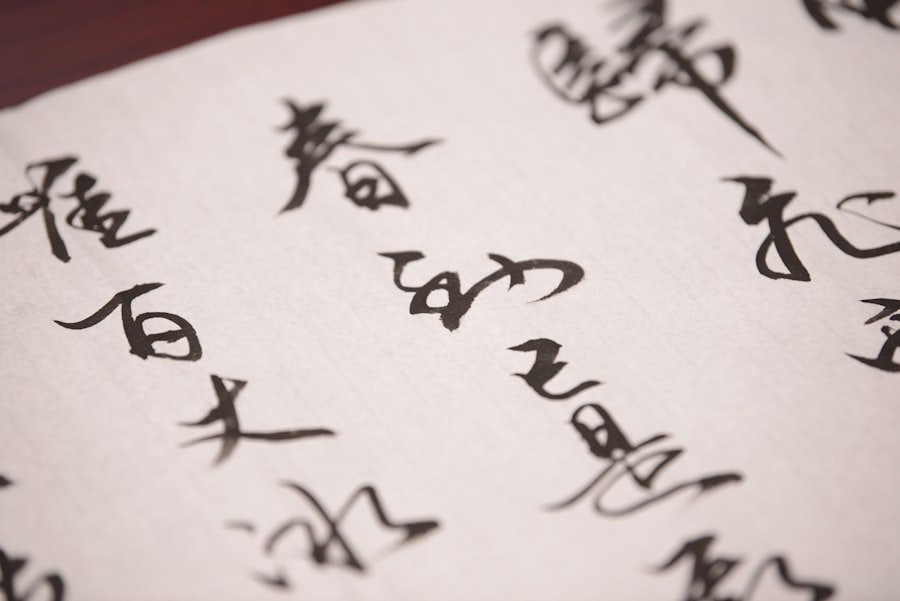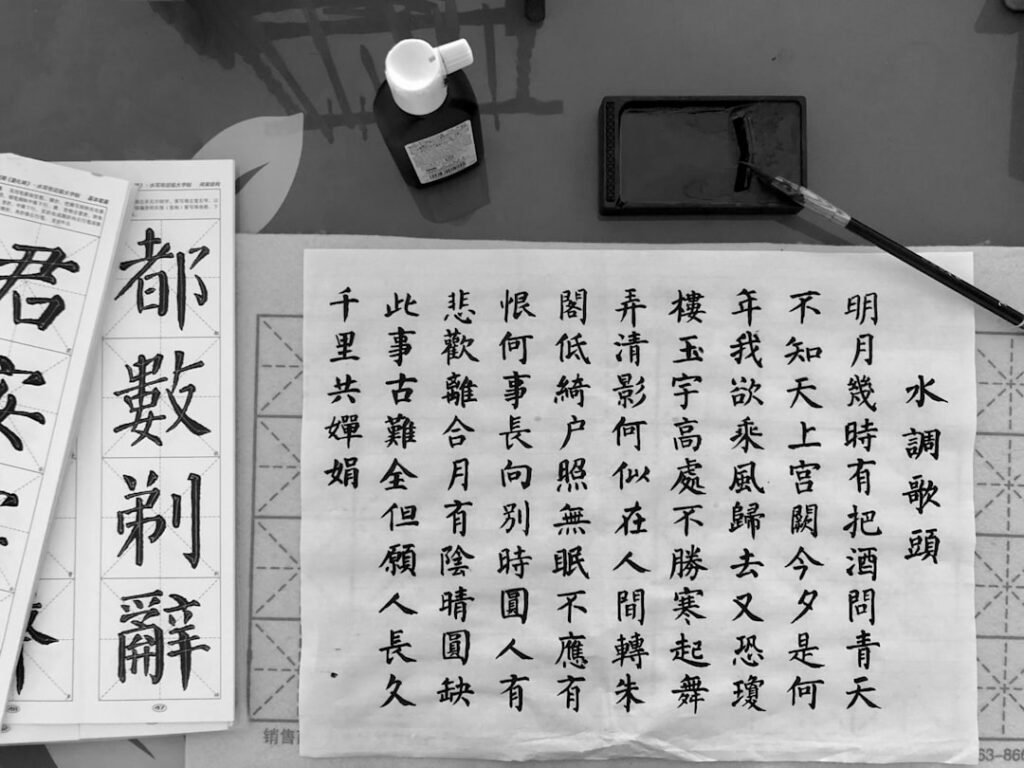Li Script, also known as Clerical Script, has a rich and storied history that dates back to the Han Dynasty (206 BCE – 220 CE). It emerged as a response to the need for a more efficient and legible form of writing, particularly for administrative purposes. The evolution of Li Script can be traced through various dynasties, with its roots firmly planted in the earlier Seal Script.
As the Han Dynasty progressed, the bureaucratic demands of the empire necessitated a script that was not only aesthetically pleasing but also practical for record-keeping. This led to the refinement of Li Script, which became widely adopted by officials and scholars alike. The development of Li Script continued through the subsequent dynasties, particularly during the Wei and Jin periods (220-420 CE), when it underwent further transformation.
Calligraphers began to experiment with the style, leading to a more fluid and expressive form of writing. By the Tang Dynasty (618-907 CE), Li Script had reached its zenith, becoming a prominent style in both official documents and artistic expressions. The script’s evolution reflects the changing cultural and political landscapes of China, showcasing how language and art are intertwined with history. Master the art of Chinese calligraphy. Enroll now at the LC Chinese School in Oslo.
Table of Contents
ToggleSummary
- Li Script originated in the Han Dynasty and has evolved over centuries, influenced by various historical and cultural factors.
- The script is known for its elegant and graceful style, with distinctive features such as long horizontal strokes and flowing lines.
- Li Script holds great significance in Chinese calligraphy, representing traditional values and influencing other calligraphy styles.
- Mastering Li Script requires patience and practice, with techniques such as controlling brush pressure and stroke order being essential.
- Renowned calligraphers such as Wang Xizhi and Yan Zhenqing have made significant contributions to the development of Li Script.
The Characteristics of Li Script: Understanding its Unique Features and Style
Li Script is characterised by its distinctive strokes and structure, which set it apart from other forms of Chinese calligraphy. One of its most notable features is the use of angular strokes, which lend a sense of strength and stability to the characters. The script is often described as having a bold and robust appearance, making it particularly suitable for inscriptions and official documents.
The balance between straight lines and curves creates a harmonious visual effect that is both pleasing to the eye and easy to read. Another defining characteristic of Li Script is its emphasis on rhythm and flow. Calligraphers often employ a dynamic movement when writing, allowing the ink to dance across the paper.
This fluidity not only enhances the aesthetic appeal but also reflects the calligrapher’s emotional state at the time of writing. The interplay between tension and release in each stroke adds depth to the characters, making them come alive on the page. This unique combination of strength and grace is what makes Li Script a favourite among both practitioners and admirers of Chinese calligraphy.
The Importance of Li Script in Chinese Calligraphy: Exploring its Significance and Influence

Li Script holds a significant place in the canon of Chinese calligraphy, serving as a bridge between ancient traditions and modern practices. Its historical importance cannot be overstated; it was the script used for many official documents during the Han Dynasty and beyond, thus playing a crucial role in governance and administration. The clarity and legibility of Li Script made it an ideal choice for bureaucratic communication, ensuring that important information was conveyed accurately.
Moreover, Li Script has influenced countless calligraphers throughout history. Many renowned artists have drawn inspiration from its elegant forms, incorporating elements of Li Script into their own styles. The script’s adaptability has allowed it to evolve over time while maintaining its core characteristics.
Today, it continues to inspire contemporary artists who seek to blend traditional techniques with modern sensibilities, ensuring that Li Script remains relevant in the ever-changing landscape of Chinese calligraphy.
Learning Li Script: Tips and Techniques for Mastering this Elegant Clerical Script
Mastering Li Script requires dedication, practice, and an understanding of its unique characteristics. For beginners, it is essential to start with the basic strokes that form the foundation of the script. Practising these strokes repeatedly will help develop muscle memory and improve overall control over the brush.
It is advisable to use high-quality materials, such as rice paper and traditional brushes, as these can significantly impact the final outcome. In addition to practising strokes, aspiring calligraphers should study examples of Li Script from renowned masters. Analysing their work can provide valuable insights into stroke order, spacing, and composition.
Joining a calligraphy class or workshop can also be beneficial, as it allows learners to receive feedback from experienced instructors. At LC Chinese School in Oslo, students have the opportunity to engage in specialised courses focused on Chinese calligraphy, including Li Script. These classes not only teach technical skills but also foster an appreciation for the cultural significance of this art form.
Famous Li Script Calligraphers: Examining the Work of Renowned Artists and Scholars
Throughout history, many calligraphers have made significant contributions to the development and popularisation of Li Script. One such figure is Wang Xizhi, often regarded as one of China’s greatest calligraphers. Although he is primarily known for his running script, his works also exhibit elements of Li Script, showcasing his mastery over various styles.
His influence on subsequent generations of calligraphers cannot be overstated; his techniques and philosophies continue to resonate within the art form today. Another notable figure is Ouyang Xun, a prominent calligrapher from the Tang Dynasty who is celebrated for his exceptional command of Li Script. His works are characterised by their boldness and clarity, setting a standard for future practitioners.
Ouyang Xun’s dedication to refining Li Script has left an indelible mark on Chinese calligraphy, inspiring countless artists to explore this elegant style further.
Li Script in Art and Literature: Exploring its Use in Traditional Chinese Culture

Li Script has played a vital role in traditional Chinese culture, serving as a medium for artistic expression as well as literary communication. In ancient times, scholars often used Li Script to inscribe poetry and philosophical texts on scrolls or stone tablets. The script’s clarity made it an ideal choice for conveying complex ideas in an accessible manner.
As a result, many classical works have been preserved in this elegant script, allowing future generations to appreciate their beauty and wisdom. In addition to literature, Li Script has found its place in various art forms, including painting and seal carving. Artists often incorporate calligraphic elements into their paintings, creating a harmonious blend of visual art and written language.
This interplay between text and image enriches the overall aesthetic experience, inviting viewers to engage with both the artistic and literary dimensions of Chinese culture.
Li Script in Modern Times: Examining its Continued Relevance and Application
Despite the rapid advancements in technology and communication methods, Li Script remains relevant in modern times. Many contemporary artists continue to explore this traditional form of calligraphy, infusing it with new ideas and techniques. The resurgence of interest in traditional arts has led to a renewed appreciation for Li Script among younger generations who seek to connect with their cultural heritage.
Moreover, Li Script is often featured in exhibitions and cultural events that celebrate Chinese art and history. Calligraphy competitions showcase the talents of both amateur and professional artists, fostering a sense of community among practitioners. Educational institutions also play a crucial role in promoting Li Script; schools like LC Chinese School in Oslo offer specialised courses that teach students not only how to write in this elegant style but also its historical context and cultural significance.
Comparing Li Script with Other Chinese Calligraphy Styles: Understanding its Distinctive Qualities
When comparing Li Script with other styles of Chinese calligraphy, such as Regular Script or Running Script, several distinctive qualities emerge. While Regular Script is known for its precision and uniformity, Li Script strikes a balance between structure and expressiveness. The angular strokes characteristic of Li Script give it a bold appearance that sets it apart from the more fluid nature of Running Script.
Additionally, each style serves different purposes within Chinese culture. Regular Script is often used for formal documents due to its clarity, while Running Script is favoured for personal correspondence because of its speed and fluidity. In contrast, Li Script occupies a unique space that combines functionality with artistic expression, making it suitable for both official use and creative endeavours.
Preserving and Promoting Li Script: Efforts to Safeguard this Traditional Art Form
As with many traditional art forms, there are ongoing efforts to preserve and promote Li Script in contemporary society. Various organisations and cultural institutions are dedicated to safeguarding this heritage by organising workshops, exhibitions, and competitions that highlight the beauty of calligraphy. These initiatives not only raise awareness about Li Script but also encourage participation from individuals of all ages.
Educational institutions play a pivotal role in this preservation effort as well. By incorporating calligraphy into their curricula, schools can instil an appreciation for this art form among students from a young age. At LC Chinese School in Oslo, dedicated courses on Chinese calligraphy provide students with hands-on experience while fostering an understanding of its cultural significance.
The Cultural Significance of Li Script: How it Reflects Chinese Values and Aesthetics
Li Script embodies many values central to Chinese culture, such as harmony, balance, and respect for tradition. The meticulous nature of calligraphy reflects a deep appreciation for craftsmanship and attention to detail—qualities that are highly regarded in Chinese society. Furthermore, the act of writing itself is seen as a meditative practice that fosters self-discipline and mindfulness.
The aesthetics of Li Script also resonate with broader philosophical concepts found within Chinese culture. The balance between strength and grace in each stroke mirrors the yin-yang philosophy that underpins much of Chinese thought. This connection between calligraphy and cultural values highlights how art can serve as a reflection of societal beliefs and ideals.
The Future of Li Script: Exploring its Potential for Innovation and Evolution
As we look towards the future, there is immense potential for innovation within the realm of Li Script. Contemporary artists are already experimenting with new materials and techniques that challenge traditional boundaries while honouring the essence of this elegant script. Digital technology offers exciting possibilities for creating hybrid forms that blend traditional calligraphy with modern design elements.
Moreover, educational initiatives aimed at younger generations will play a crucial role in ensuring that Li Script continues to thrive. By fostering an environment where creativity meets tradition—such as those offered at LC Chinese School in Oslo—students can explore their artistic expression while gaining a deeper understanding of their cultural heritage. This fusion of old and new will undoubtedly shape the future trajectory of Li Script as it evolves within an ever-changing world.
In conclusion, Li Script stands as a testament to China’s rich cultural heritage—a beautiful blend of history, artistry, and philosophy that continues to inspire generations today. Through dedicated efforts in education and preservation, this elegant clerical script will undoubtedly endure as an integral part of Chinese identity for years to come.
Master the art of Chinese calligraphy. Enroll now at the LC Chinese School in Oslo.







